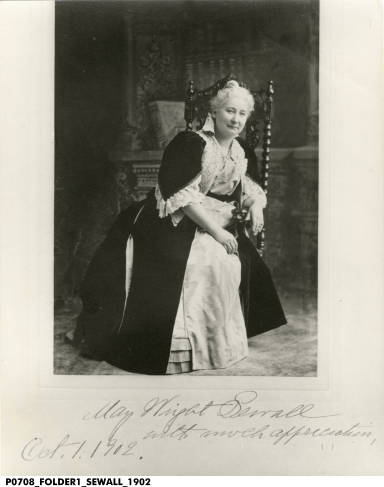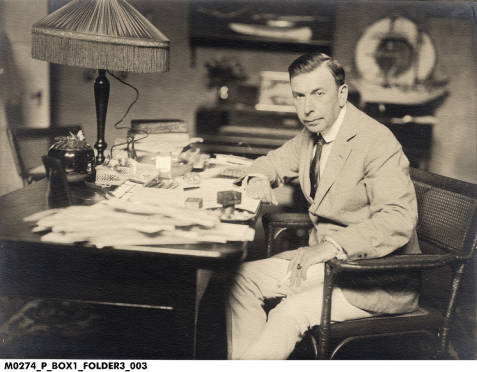
Purchase Tickets
Our (FREE) parking lot is located on New York Street a ½ block east of West Street. Free parking with admission.
“The Last Enemy is Destroyed”-May Wright Sewall and Spiritualism
May 18, 2020

A century ago an Indianapolis publishing firm, Bobbs-Merrill Company, released a volume that it publicized as the “most talked of book of the day.” Anton Scherrer, a columnist for the Indianapolis Times, said that nothing “rocked the foundations of Indianapolis quite as much” as had the appearance of the publication, titled Neither Dead nor Sleeping.
Written by former Indianapolis civic leader May Wright Sewall, the book, released two months before her death on July 22, 1920, detailed her extensive experiences in the shadowy world of spiritualism—the belief in the possibility of the living communicating with the dead. Sewall’s communion with the deceased, which included extensive conversations with her late husband Theodore, shocked many who knew the no-nonsense teacher, suffragette and peace advocate.
After all, this proponent of spiritualism had played a leading role in helping to establish such Indianapolis institutions as the Girls’ Classical School, the Indianapolis Woman’s Club, the Contemporary Club, the Art Association of Indianapolis, and the Indianapolis Propylaeum. She also worked tirelessly to promote rights for women in the United States—and around the world—during the late nineteenth and early twentieth centuries, serving as an invaluable ally to such national suffrage leaders as Susan B. Anthony and Elizabeth Cady Stanton. Sewall also gave the woman’s movement an international focus through her pioneering involvement with the International Council of Women and the National Council of Women.
Nobody in her old hometown, however, knew about Sewall’s contacts with the spirit world. In fact, only a dozen or so people knew about this side of her life. During Sewall’s communications with her departed husband, he had warned her, she told a reporter from the Indianapolis Star, not to relate them “to the world until she had them in such form the world could understand them.” Also, those to whom she related her experiences often expressed the belief that Sewall suffered from a mental delusion. Perhaps realizing that she would be ridiculed by many for her otherworldly experiences, which first occurred in 1897, she decided to relate her spiritualist story to the world only when “extreme feebleness” had taken her once and for all out of public affairs.
Sewall’s remarkable account of her communications with the spirit world became known to the living through the unstinting efforts of an Indiana writer who had his own experience with unexplained phenomena: Booth Tarkington. When he was fourteen years old and living in Indianapolis, Tarkington discovered that his sister, Hauté, had psychic powers. The Tarkington family hosted séances at its home that drew such distinguished visitors as James Whitcomb Riley. When May Wright Sewall approached him for assistance in finding a publisher for her spiritualist manuscript, Tarkington was glad to help.

Booth Tarkington (1869–1946) was a native of Indianapolis who became one of Indiana’s most famous authors, both as playwright and as novelist.
By March 1919 Tarkington had decided to place the manuscript with the Bobbs-Merrill Company, which could trace its roots in Indianapolis back to the 1850s and was the publisher for such Hoosier literary lions as James Whitcomb Riley, George Ade, Meredith Nicholson and Maurice Thompson. Sometime in August Bobbs-Merrill agreed to publish Sewall’s spiritualist book. One of the reasons for the firm’s acceptance might have been its eagerness to add Tarkington to its list of authors. For his part, Tarkington continued to advise the suffragist on the terms of her contract and tried to convince Sewall not to believe that his “small” contribution had induced Bobbs-Merrill to accept the book. His efforts on her behalf did perhaps pique the firm’s interest in reviewing the manuscript, but it was the work “itself, and nothing else whatever, that has brought them to their favorable decision.”
In early October 1919 Sewall returned to Indianapolis, taking up residence at a convalescent home at 1732 North Illinois Street. Although so ill with heart disease that she had trouble breathing and had to be propped up in bed by pillows, Sewall was able to correct on galley proofs of her book. Despite her illness, she remained confident about the worth of her manuscript. “I think I never did a better piece of proof reading—and I am perfectly delighted with the book,” she told her editor at Bobbs-Merrill. “I know it will have an ultimate great success.”
Reviewers were kind to Sewall’s book. Writing for the Chicago Tribune, Elia W. Peattie claimed that the book had been written in “good faith” by a “gentlewoman of high veracity.” The author had found, Peattie added, an “escape from illness and sorrow, and there remains but to extend to her sincere and deeply felt congratulations.” Reviewing several books on psychic experiences for the New York Evening Post, J. Keith Torbert wrote that both for those who believe and for those who scoff at spiritualism May’s book “has essentials to reveal,” and pointed out that the “strong, admirable character of Mrs. Sewall appears on every page.”
These vindications of her work came as Sewall, now seventy-six years old, lay gravely ill in her room at Saint Vincent’s Hospital, where she finally died at 11:15 P.M. on July 22, 1920. After funeral services at All Souls Unitarian Church, overseen by Reverend S. C. Wicks, May was buried alongside her beloved husband, Theodore, at Crown Hill Cemetery. In the death of Sewall, the Indianapolis News said on its editorial page, the world lost a citizen. Throughout her life, the newspaper said, “Mrs. Sewall possessed the faculty of transmitting her boundless enthusiasm and her original ideas to the world around her. One could not slumber in her presence for her vitality was contagious.”
Learn more about May Wright Sewall’s remarkable life in the IHS Press youth biography Fighting for Equality: A Life of May Wright Sewall. Copies are available through the IHS’s Basile History Market.









